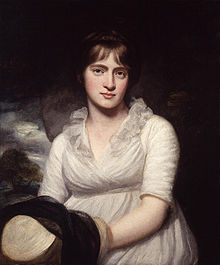

Queer Places:
Northrepps Cottage, Northrepps Rd, Cromer NR27 0JR, Regno Unito
Gildencroft Quaker Cemetery, Chatham St, Norwich NR3 3DN, Regno Unito
 Amelia
Opie, née Alderson (12 November 1769 – 2 December 1853), was an English
author who published numerous novels in the Romantic Period of the early 19th
century, through 1828. Opie was also a leading abolitionist in Norwich. When
187,000 names were presented to the British parliament as a petition from
women to stop slavery, Amelia Opie was the first name.
Amelia
Opie, née Alderson (12 November 1769 – 2 December 1853), was an English
author who published numerous novels in the Romantic Period of the early 19th
century, through 1828. Opie was also a leading abolitionist in Norwich. When
187,000 names were presented to the British parliament as a petition from
women to stop slavery, Amelia Opie was the first name.
She was born Amelia Alderson, the daughter of James Alderson, a physician, and Amelia Briggs of Norwich, England. She was a cousin of notable judge Edward Hall Alderson, with whom she corresponded throughout her life, and also a cousin of notable artist Henry Perronet Briggs.
Miss Alderson had inherited radical principles and was an ardent admirer of John Horne Tooke. She was close to activists John Philip Kemble, Sarah Siddons, William Godwin and Mary Wollstonecraft.[1]
In 1798, Alderson married John Opie, the painter. The couple spent nine years in married happiness, although her husband did not share her love of society. With her husband's encouragement, Amelia completed a novel in 1801 titled Father and Daughter, which showed genuine fancy and pathos.[1]
After her novel Father and Daughter was published in 1801, Amelia Opie began to publish regularly. Her volume of Poems, published in 1802 went through six editions, and was followed by The Warrior's Return and other poems in 1808.[2] More novels followed: Adeline Mowbray (1804), Simple Tales (1806), Temper (1812), Tales of Real Life (1813), Valentine's Eve (1816), Tales of the Heart (1818), and Madeline (1822).
Opie wrote The Dangers of Coquetry when she was only 18 years old. Her novel Father and Daughter (1801) is about misled virtue and family reconciliation. Encouraged by her husband to continue writing, she published Adeline Mowbray (1804), an exploration of women's education, marriage, and the abolition of slavery. This novel in particular is noted for engaging the history of Opie's former friend Mary Wollstonecraft, whose relationship with the American Gilbert Imlay outside of marriage caused some scandal, as did her later marriage to the philosopher William Godwin. Godwin had previously argued against marriage as an institution by which women were owned as property, but when Wollstonecraft became pregnant, they married despite his prior beliefs. In the novel, Adeline becomes involved with a philosopher early on, who takes a firm stand against marriage, only to be convinced to marry a West Indian landowner against her better judgment. The novel also engages abolitionist sentiment, in the story of a mixed-race woman and her family whom Adeline saves from poverty at some expense to herself.
Amelia Opie divided her time between London and Norwich, England. She was a friend of writers Sir Walter Scott, Richard Brinsley Sheridan and Madame de Stael.
In 1825, Amelia Opie joined the Society of Friends, due to the influence of Joseph John Gurney and his sisters, who were long-time friends and neighbours in Norwich,[1] despite the objections to it made by her recently deceased father. The rest of her life was spent mostly in travel and working with charities. In the meantime, however, she published an anti-slavery poem titled, The Black Man's Lament in 1826 and a volume of devotional poems, Lays for the Dead in 1834.[3] Opie worked with Anna Gurney to create a Ladies Anti-Slavery Society in Norwich.[4] This anti-slavery society organised a petition of 187,000 names that was presented to parliament. The first two names on the petition were Amelia Opie and Priscilla Buxton.[5]
Opie went to the World's Anti-Slavery Convention in London in 1840 where she was one of the few women included in the commemorative painting.
Even late in her life, Opie maintained connections with writers, for instance receiving George Borrow as a guest. After a visit to Cromer, a seaside resort on the North Norfolk coast, she caught a chill and retired to her bedroom. A year later on 2 December 1853, she died at Norwich and was said to retain her vivacity to the last. She was buried at the Gildencroft Quaker Cemetery, Norwich.
A somewhat sanitised biography of Amelia Opie, titled A Life, by Miss C.L. Brightwell, was published in 1854.
My published books: